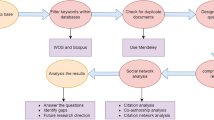Abstract
The paper presents a new version of the multicriteria decision support system SADAGE for solving ranking problems: how to rank a set of alternatives—having evaluations in terms of several criteria—in decreasing order of preference. It uses the ELECTRE III methodology to construct a fuzzy outranking relation, and then a genetic algorithm (GA) or a multiobjective evolutionary algorithm (MOEA) to exploit it and to obtain a recommendation. The GA and the MOEA approaches rest on the main idea of reducing differences between the global model of preferences and the final ranking. The system operation is showed within an illustrating example.








Similar content being viewed by others
References
Bouyssou D, Vincke P (1997) Ranking alternatives on the basis of preference relations: a progress report with special emphasis on outranking relations. J Multi-Criteria Decis Anal 6:77–85
Brans JP, Vincke P, Mareschal B (1986) How to select and how to rank projects: The PROMETHEE method. Eur J Oper Res 24:228–238
Fernández Gonzalez E, Leyva López JC (2004) A method based on multiobjective optimization for deriving a ranking from a fuzzy preference relation. Eur J Oper Res 154(1):110–124
Fodor J, Roubens M (1994) Fuzzy preference modeling and multicriteria decision support. Kluwer, Dordrecht
Fonseca CM, Fleming PJ (1993) Genetic algorithms for multiobjective optimization: formulation, discussion and generalization. In: Genetic algorithms: proceedings of the fifth international conference. Morgan Kaufmann, Los Altos, pp 416–423
French S (1986) Decision theory: an introduction to the mathematics of rationality. Halsted Press, New York
Goldberg D (1989) Genetic algorithms in search, optimization, and machine learning. Addison-Wesley, Reading
Keen PGW, Scott Morton MS (1978) Decision support systems, an organizational perspective. Addison-Wesley, Reading
Keeney R, Raiffa H (1976) Decision with multiple objectives: preferences and value tradeoffs. Wiley, New York
Leyva López JC (2005) Multicriteria decision aid application to a student selection problem. Pesqui Oper 25(1):45–68
Leyva López JC, Aguilera Contreras MA (2005) A multiobjective evolutionary algorithm for deriving final ranking from a fuzzy outranking relation. In: Coello Coello CA, Zitzler E, Hernández Aguirre A (eds) Evolutionary multi-criterion optimization. Third international conference, EMO 2005. Lecture notes in computer science, vol 3410, pp 235–249. Springer, Heidelberg
Leyva López JC, Dautt Sánchez L (2005) A new decision support system for rank a finite set of multicriteria alternatives. Invest Oper 26(3):1–11
Leyva López JC, Fernández González E (1999) A genetic algorithm for deriving final ranking from a fuzzy outranking relation. Found Comput Decis Sci 24(1):33–47
Michalewicz Z (1996) Genetic algorithms + data structures = evolution programs. Springer, Berlin
Orlovski SA (1978) Decision-making with a fuzzy preference relation. Fuzzy Sets Syst 1:155–167
Roy B (1990) The outranking approach and the foundations of ELECTRE methods. In: Bana e Costa CA (ed) Reading in multiple criteria decision aid. Springer, Berlin, pp 155–183
Roy B (1996) Multicriteria methodology for decision aiding. Kluwer, Dordrecht
Roy B (1977) Partial preference analysis and decision aid: the fuzzy outranking relation concept. In: Bell DE, Keeney RL, Raiffa H (eds) Conflicting objectives in decisions. Wiley, Chichester, pp 40–75
Turban E, Aronson JE (2001) Decision support systems and intelligent systems. Prentice-Hall, New Jersey
Vallée D, Zielniewicz P (1994) ELECTRE III–IV, version 3.x—Aspects methodologiques. Université de Paris-Dauphine, Document du LAMSADE, no. 82, 52 p
Vanderpooten D (1990) The construction of prescriptions in outranking methods. In: Bana e Costa CA (ed) Reading in multiple criteria decision aid. Springer, Berlin, pp 184–215
Author information
Authors and Affiliations
Corresponding author
Rights and permissions
About this article
Cite this article
Leyva López, J.C., Dautt Sánchez, L. & Aguilera Contreras, M.A. A multicriteria decision support system with an evolutionary algorithm for deriving final ranking from a fuzzy outranking relation. Oper Res Int J 8, 47–62 (2008). https://doi.org/10.1007/s12351-008-0006-6
Received:
Revised:
Accepted:
Published:
Issue Date:
DOI: https://doi.org/10.1007/s12351-008-0006-6




